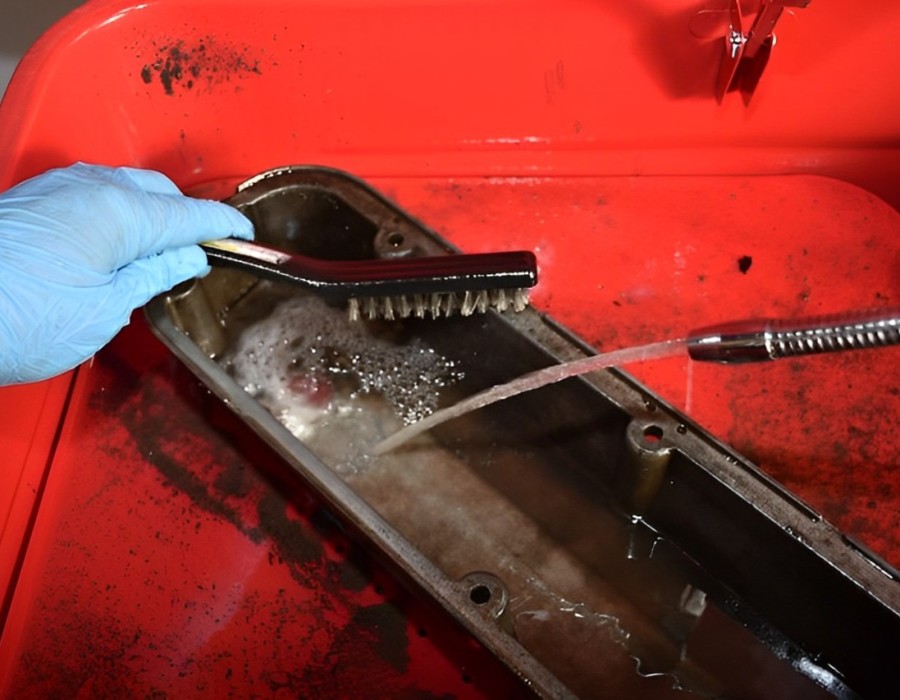Manufacturing processes often require cleaning parts to remove contaminants like oil, grease, coolants, and metal shavings. Traditionally, solvent-based cleaners have been the go-to solution. However, these cleaners raise concerns about environmental impact and worker safety due to their toxic nature, and water-based parts cleaners have become known to be a safer and more eco-friendly alternative.
Why Choose Water-Based Cleaning Solutions
Water-based cleaners are a better choice than solvent-based solutions because they are formulated with water as the primary solvent and utilize detergents, surfactants, and other cleaning agents to remove contaminants effectively. These cleaners offer several key advantages, such as:
· Reduced Hazardous Waste: Water-based parts cleaners are generally classified as non-hazardous waste, significantly simplifying disposal procedures. In many cases, the used cleaning solution can be treated and reused, further minimizing waste generation.
· Lower VOC Emissions: Water-based cleaners have significantly lower VOC content compared to solvent-based solutions. This reduces air pollution and improves air quality within manufacturing facilities, promoting a healthier environment for workers.
· Enhanced Worker Safety: Water-based cleaners are generally less toxic than solvent-based cleaners, reducing the risk of skin irritation, respiratory problems, and other health issues for workers. Using a water based parts washer cleaning solution, in particular, requires less stringent PPE requirements when handling, improving worker comfort and safety.
How Water-Based Cleaners Work
Water-based cleaners utilize a combination of mechanisms to remove contaminants:
· Detergents: These act as surfactants, lowering the surface tension between the contaminant and the part's surface. This allows for easier penetration and breakdown of the contaminant, allowing water to wash it away.
· Alkaline or Acidic Solutions: Depending on the type of contaminant, water-based cleaners might be formulated with mild alkaline or acidic properties. These solutions can help dissolve specific types of contaminants, such as grease or oxides.
· Agitation: Mechanical agitation, such as ultrasonic waves or spray cleaning, can be used with the water-based cleaner to enhance its cleaning power and remove stubborn contaminants.
Where Water-Based Cleaners are Used in Manufacturing
Here are examples of manufacturing equipment that can benefit from water-based cleaning solutions:
· Engine Blocks and Components—Water-based cleaners effectively remove grease, oil, and carbon deposits from engine blocks, cylinder heads, and other engine components.
· Transmission Parts—Cleaning transmission cases, gears, and clutch assemblies with a water-based parts washer cleaning solution ensures proper function and longevity.
· Hydraulic Systems—They maintain cleanliness in hydraulic pumps, valves, and cylinders to prevent contamination and wear.
· Machine Tool Parts—They clean lathes, milling machines, and CNC equipment, removing metal shavings, lubricants, and coolants.
· Bearings and Bushings—They ensure bearings and bushings are free from dirt, grease, and other contaminants that can cause premature failure.
· Industrial Gearboxes—They remove debris and old lubricant from gearboxes for efficient operation and prevention of overheating.
· Electric Motors and Components—Cleaning stators, rotors, and housings with a water based parts cleaner prevents electrical failures and improves efficiency.
· Pumps and Valves—These cleaners keep pumps and valves free from contaminants for smooth operation and longevity.
· Welding Equipment—They are used to remove spatter and residue from welding torches, nozzles, and fixtures.
· Food Processing Equipment—These cleaning solutions help meet hygiene standards and prevent contamination in mixers, conveyors, and packaging.
· Electronic Assembly Equipment—Cleaning soldering machines, circuit board handlers, and other electronic assembly tools with water-based cleaners prevent contamination.
· Textile Machinery—They remove lint, oils, and dyes from looms, spinning machines, and dyeing equipment.
· Agricultural Machinery—Maintaining cleanliness in tractors, harvesters, and other agricultural equipment with a water-based parts cleaner helps with reliability and performance.
Additional Benefits
In addition to their role in reducing toxic waste, water-based cleaners offer other benefits for manufacturers:
· Cost Savings: While the initial cost of a water-based cleaning system might be higher upfront, the reduced waste disposal costs and lower VOC emissions (which can be subject to regulations and fines) can lead to significant long-term cost savings.
· Improved Cleaning Efficiency: Modern water-based cleaning systems can be highly efficient, offering faster cleaning times and potentially reducing energy consumption compared to traditional solvent-based cleaning methods.
Versatility: Water-based cleaners are available in various formulations designed to tackle a wide range of contaminants and are compatible with various materials used in manufacturing.





Comments